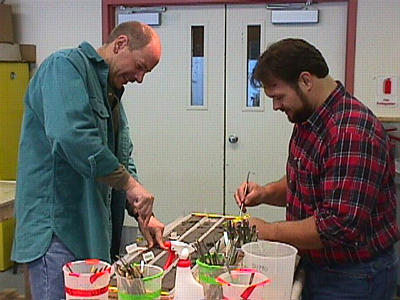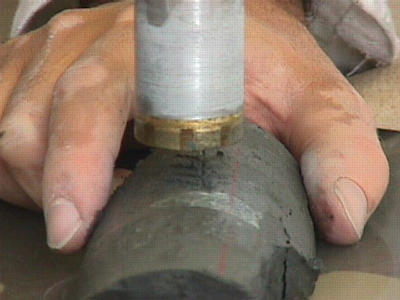5 November, 1998
Thursday, November 5, 1998
Hello again! I slept in this morning to catch up on sleep after my "Happy
Camper" field training. I had a meeting to attend at Crary Lab for the Cape
Roberts Project, so I had to be there at 10:00 AM. This was an exciting day
for our project. Yesterday while I was gone scientists received word that
evidence of a large volcanic eruption had been discovered in the most recent
sections of core. This was the day we could all get a look at those samples!
I want to include part of a press release that was drafted today.
"Ancient Antarctic Environment Rocked by Volcanic Eruptions"
"A scientific study of rock cores presently being drilled from the bottom of
the western Ross Sea, Antarctica, has unexpectedly recovered the first
evidence of large volcanic eruptions that occurred in the area around 25
million years ago. The evidence of this activity is contained in layers of
volcanic debris that were erupted explosively into the atmosphere and then
settled through the air and the ocean onto the seafloor. The thickness and
coarseness of the main debris layer indicates a large volume eruption that
generated an ash cloud reaching 50 to 70 km into the stratosphere. The
discovery of these volcanic layers demonstrates a far more spectacular history
of volcanic activity than was previously suspected for the Ross Sea region of
Antarctica, but it is also useful because it provides material for accurately
dating the strata."
Peter Webb gave us the latest drilling status, and he announced that the
downhole loggers were going to the drill site to take measurements down the
drill hole. We had a presentation by Hannes Grobe, from Germany, who works at
the facility where the "working" half of the Cape Roberts cores are stored
after they leave Antarctica. The working half of the cores are the ones that
we drill from and other teams take their samples from. The "archive" half of
the Cape Roberts cores are stored in an NSF funded facility at Florida State
University. This is called the Antarctic Core Repository. The archive half
of the cores are the ones that are pretty much untouched during the McMurdo
sampling process. These can be used later by researchers.
After lunch I worked with Gary and Leo in the core sampling room, and a small
room just outside that houses the drill we use to take our small core samples.
Gary prepared the parts of the core we were going to sample by turning them
over onto a tray…curved side facing up. An arrow on the tray indicated which
way the sample came out of the drill hole. It was important to keep this
orientation correct. Leo and I worked in the small room outside (which
reminded me of a freezer with its big silver handle that opened like one).
Leo would carefully place the core in an area under the drill bit. He wet the
core and started to drill slowly, using water to cool the drill bit as
friction heated it up. I assisted by holding each piece of the core very still
so it wouldn't shift during the drilling process. After each sample was
drilled, I brought the tray back inside the core sampling room to Gary. He
placed the core back in the larger box it came from, and later Tom and Matt
(curators of the core) put styrofoam pieces in the empty spots we had drilled
out. This will keep the core from shifting during shipment. We drilled 30
samples today! Leo even let me have a turn at drilling. That was FUN!
While we were hard at work with the drilling process, Tom and Matt took
samples for the other groups of scientists-based on where they had placed
their flags. These samples where dug out with small tools, and the sediments
were placed into small plastic bags, labeled with the scientist's name, and
exactly where on the core the sample came from. This same process is repeated
every time new boxes of core come into Crary Lab.
Back in the paleomag lab, Fabio measured samples using the spinner
magnetometer. Leo, Gary and I went to ANOTHER room and Leo used an electric
saw to trim up the samples so they would be 1 inch long. This is done so
that the sample fits in our machines correctly. I helped out by drawing the
orientation line on each sample with a pencil. I handed them off to Gary,who
recorded information and placed the round samples on a tray to dry. Can you
imagine doing all of these steps? Just wait…we haven't really begun to sample
using all of our machines yet.
This was a long day in the lab, but I felt great getting into the science
involved in this project. Watching all of the various teams examine the core,
flag their sample areas, and working with Gary and Leo made me feel like a
real scientist…even though I don't always understand every single aspect of
the Cape Roberts project. I am learning a lot each day, and I hope you are,
too. Talk with you tomorrow.
Betty :)

Tom (left) and Matt collect the samples for other teams of scientists. They use small tools to dig out the sample which is placed in a plastic bag.

This photo shows the drill bit up close, with a core ready to be drilled placed right underneath it. You can get an idea of the size, based on Leo's hands in the photo.

Fabio was back in our paleomag lab working on measurements of samples...here shown using the spinner magnetometer.
Contact the TEA in the field at
.
If you cannot connect through your browser, copy the
TEA's e-mail address in the "To:" line of
your favorite e-mail package.
|
